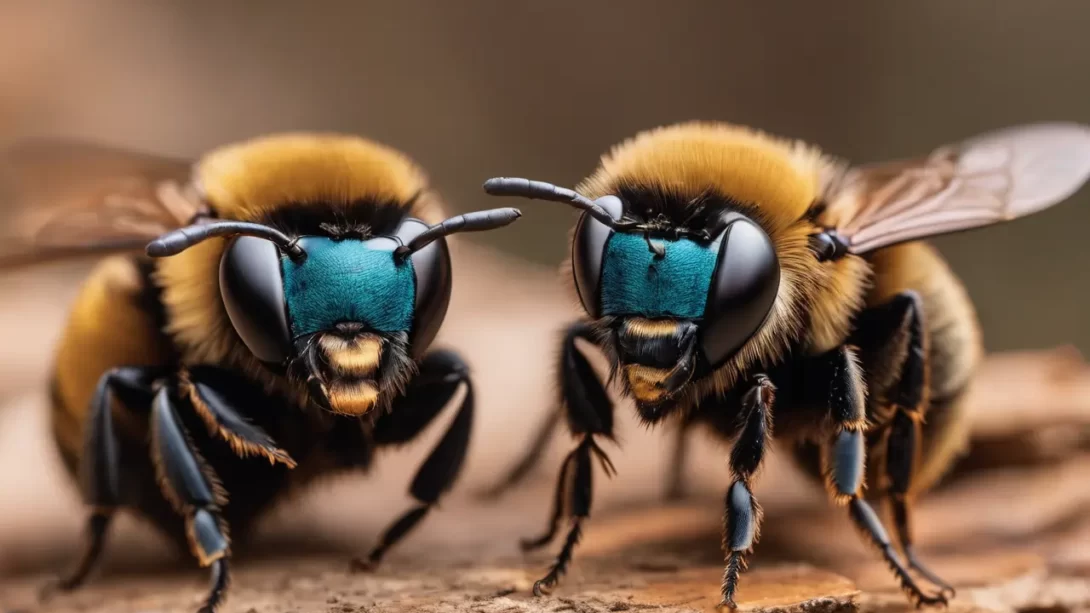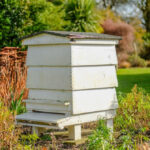Carpenter bees, often mistaken for their close relatives, the bumblebees, are a common sight in many gardens and wooded areas. While generally harmless to humans, these bees can cause significant damage to wooden structures by burrowing into them to lay their eggs. This has led many homeowners to seek effective methods of control, including the use of wasp sprays. This article explores the viability of using wasp spray against carpenter bees and the implications of such a choice.
Carpenter Bees
Carpenter bees are large, solitary bees known for their ability to drill into wood. Unlike termites, they do not consume the wood but excavate tunnels for nesting purposes. These bees are generally black and yellow, resembling bumblebees, but with a smoother, less hairy abdomen. Carpenter bees prefer untreated, exposed wood, often targeting eaves, window trims, and fascia boards on houses. Their burrowing not only causes aesthetic damage but can also weaken structural integrity over time. Understanding their behavior is crucial in effectively managing and preventing infestations.
Wasp Spray: Composition and Purpose
Wasp sprays are insecticides formulated primarily to kill wasps and hornets. They usually contain chemicals like pyrethroids, which are synthetic insecticides, and other compounds designed to quickly incapacitate and kill these insects. The sprays often have a long-range, allowing users to treat nests from a distance safely. While these sprays are effective against wasps and hornets, their effectiveness on other insects, such as carpenter bees, is not as clear-cut. The specificity of insecticide formulations means that what works for one type of insect may not be as effective for another.
Effectiveness of Wasp Spray on Carpenter Bees
The effectiveness of wasp spray on carpenter bees is a topic of debate. While these sprays can be lethal to a wide range of insects, their impact on carpenter bees may not be as immediate or effective as it is on wasps and hornets. Carpenter bees are larger and may have a higher resistance to the chemicals in wasp sprays. Moreover, the application method – typically a direct spray – might not reach the bees if they are deep inside their burrows. This limited effectiveness highlights the need for more targeted approaches when dealing with carpenter bee infestations.
Potential Risks and Considerations
Using wasp spray to control carpenter bees comes with several risks and considerations. Firstly, the environmental impact cannot be overlooked. Insecticides can harm non-target species, particularly beneficial pollinators like honeybees and butterflies, contributing to broader ecological imbalances. Additionally, the chemicals in these sprays can be harmful to pets and humans, especially if used improperly or in enclosed spaces.
There is also the issue of long-term effectiveness. Wasp sprays may provide a temporary solution but often fail to address the underlying problem: the wooden structures that attract carpenter bees. Without proper treatment and preventive measures, bees are likely to return, leading to a recurring problem.
Alternative Solutions for Controlling Carpenter Bees
Given the limitations and risks associated with using wasp spray, exploring alternative solutions for controlling carpenter bees is essential. These alternatives not only provide more effective results but also tend to be safer for the environment and non-target species. Physical removal and preventive measures, such as sealing and treating wood, are primary steps. Carpenter bee-specific insecticides, which are formulated to target these bees more effectively, can be a better choice than general wasp sprays. Additionally, non-toxic alternatives, like natural repellents and traps, offer environmentally friendly options for managing carpenter bee populations.
Natural and Non-Toxic Alternatives
For those seeking eco-friendly methods, natural and non-toxic alternatives can be effective in deterring carpenter bees. Essential oils like citrus, tea tree, and peppermint are known to repel bees when applied around their favorite nesting areas. Physical barriers, such as steel wool or aluminum foil, can block existing tunnels, preventing re-entry. Additionally, maintaining painted or varnished wood surfaces reduces the attractiveness of structures to carpenter bees, as they prefer bare, untreated wood for nesting.
Preventive Measures
Prevention is key to long-term control of carpenter bees. Regular inspections of wooden structures for signs of bee activity can help in early detection and control. Filling and sealing any holes or crevices not only deters new bees but also prevents re-infestation. Using hardwoods for outdoor structures, which are less appealing to carpenter bees, can also be a preventive strategy.
Conclusion
While wasp spray might offer a quick fix against carpenter bees, its effectiveness is limited, and it poses potential risks to the environment and human health. Understanding the behavior of carpenter bees and adopting targeted control measures can yield more effective and sustainable results. From specific insecticides to natural repellents and preventive maintenance, various methods can be employed to manage carpenter bee infestations without resorting to general wasp sprays. Emphasizing safe, targeted, and environmentally conscious approaches is crucial in effectively dealing with these wood-burrowing insects.





